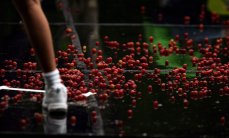Russian scientists have created a material with antibacterial properties
Russian scientists have created a durable and non-toxic polymer coating that can destroy 99.999% of pathogens. Research supported by a grant from the Russian science Foundation (RNF) and published in the journal Materials science and Engineering.

Today, a very popular so-called “cationic antiseptics”, for example, Miramistin, chlorhexidine, octenisept. They are not toxic to humans, and their aqueous solutions possess excellent bactericidal activity. In the study, the authors obtained water-insoluble polymers and coatings on their basis, which operate on a similar mechanism and also possess a high bactericidal activity.
See also Scientists have refuted the “five second rule” for dropped to the floor adymy have established General laws between chemical structure of polymers (the length of the alkyl substituent, degree of substitution, degree of crosslinking) properties — bactericidal activity and solubility in water.Ivan Businessauthor research, by grant RSF, Junior researcher of chair bioengineering, biology faculty of Moscow state University named after M. V. Lomonosov
Scientists have refuted the “five second rule” for dropped to the floor adymy have established General laws between chemical structure of polymers (the length of the alkyl substituent, degree of substitution, degree of crosslinking) properties — bactericidal activity and solubility in water.Ivan Businessauthor research, by grant RSF, Junior researcher of chair bioengineering, biology faculty of Moscow state University named after M. V. Lomonosov
According to the scientist, it was also important to obtain high-level and low-soluble compounds: coatings based on them will be washed off the longest, and therefore will be the most durable.
In the study, the authors received a series of several dozen new compounds (based on synthetic polymer — polyethyleneimine) and coatings based on them. They were studied using various physicochemical methods, including using NMR (nuclear magnetic resonance) and IR spectroscopy. We also evaluated the magnitude of the contact angle of wetting and the degree of sminaemosti water. In addition, the researchers examined their bactericidal properties. For this purpose Petri dishes coated with coatings based on the polymers, the scientists sowed the germs Staphylococcus aureus and Pseudomonas aeruginosa. Further, the experts measured the number of colony forming units.
It turned out that compared with the control, the incidence of these bacteria was below 1 000-1 000 000 times.
Thus it appeared that, in combination with low solubility and high activity according to the decrease in the number of CFU (number of bacteria forming colonies in each milliliter medium), this result indicates “contact-active” mechanism of action.Read takeintoaccount disease was the main cause of childhood obesity
The authors note that the goal of the research is to create materials, the surface of which has antibacterial properties. The development can be used including the creation of implantable medical devices, the surface of which is resistant to the formation of biofilms many microorganisms located on a certain surface. “According to various estimates, the frequency of complications (secondary infections) in the application of medical devices (orthopedic implants, catheters) – related biofilm formation, reaches 10-20% of cases. It is therefore very important that they be non-toxic to the tissues of the human body, and at the same time, quickly and effectively caused lysis (dissolution) of pathogenic microorganisms,” — says Ivan Bessonov.
In addition, according to the researchers, the findings will help in the creation of materials that can effectively absorb on the surface of a prokaryotic cell or a separate structural fragments of their cell walls, and can also be used for water purification from cyanobacteria and microalgae, which are often the cause of serious environmental consequences.